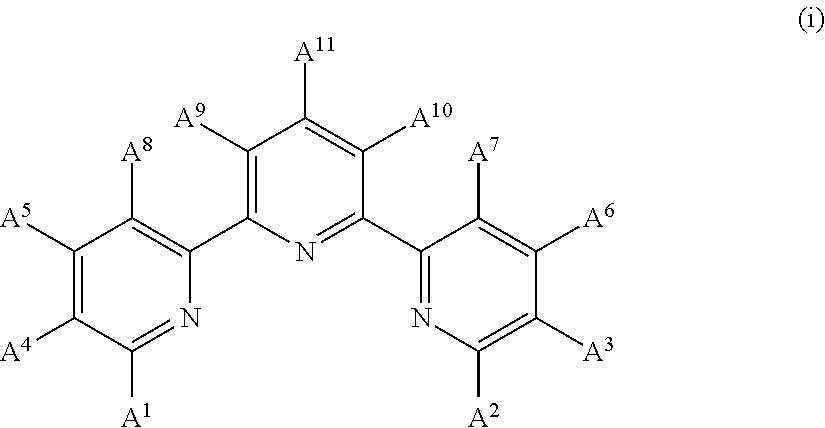Hydrosilylation Catalysts Made With Terdentate Nitrogen Ligands And Compositions Containing The Catalysts
a technology of nitrogen ligands and hydrogen ligands, which is applied in the direction of catalyst activation/preparation, catalytic reactions, iron organic compounds, etc., can solve the problems of difficult preparation of hydrosilylation catalysts, difficult to obtain metals in these hydrosilylation catalysts, and high cost of hydrosilylation catalysts
- Summary
- Abstract
- Description
- Claims
- Application Information
AI Technical Summary
Benefits of technology
Problems solved by technology
Method used
Image
Examples
example 1
Formation of Metal-Ligand Complexes
[0180]Precursor solutions were prepared by mixing an M precursor described above in Table 1 at a 0.025 molar (M) concentration with THF or, if the precursor was insoluble in THF, then a suitable solvent to dissolve the ligand selected from dimethylsulfoxide (DMSO), toluene, and hexane. Solutions of each ligand shown above in Table 2 were also prepared by mixing the ligand at a 0.025 M concentration with THF. Each ligand solution prepared above was dispensed into 2 milliliter (mL) vials at 85 microliters (μL) per vial. To prepare samples to evaluate as ingredient (A), one of the metal precursor solutions described above was added to a vial containing a ligand, and an additional 85 microliters (μL) THF was added, and the vial contents were mixed at 300 RPM at room temperature of 25° C. for 2 hours. A sufficient amount of metal precursor solution was added such that the Metal:Ligand Ratio was either 1:1 or 1:2. The resulting mixture in the vial was co...
example 2
[PhSi] Reaction
[0181]To perform the [PhSi] reaction, PhSiH3 (C2) in dodecane and 1-hexene (B3) were added to a vial prepared according to Example 1. The amount of PhSiH3 (C2) added to the vial was either 170 μL of 6.25 M (as H or SiH) PhSiH3 (C2) in dodecane, or 132.4A PhSiH3 (C2) in 37.6 μL dodecane. The amount of 1-hexene (B3) was 145 μL. Each vial was mixed overnight (for 16 h) at 50° C. The resulting contents of each vial were analyzed by GC according to the method described below.
example 3
[HMTS] Reaction
[0182]To perform the [HMTS] reaction, 1-hexene (B3) and 1,1,1,3,5,5,5-heptamethyltrisiloxane (C1) were added to a vial prepared according to Example 1. The amount of 1-hexene added was 145 μL. The amount of heptamethyltrisiloxane (C1) was either 312 μL heptamethyltrisiloxane (C1) at a concentration of 3.4 M (as H or SiH) in dodecane, or 290 μL heptamethyltrisiloxane (C1) in 22 μL dodecane. Each vial was mixed overnight (for 16 h) at 50° C. The resulting contents of each vial were analyzed by GC according to the method described below.
PUM
| Property | Measurement | Unit |
|---|---|---|
| temperature | aaaaa | aaaaa |
| temperature | aaaaa | aaaaa |
| temperature | aaaaa | aaaaa |
Abstract
Description
Claims
Application Information
 Login to View More
Login to View More - Generate Ideas
- Intellectual Property
- Life Sciences
- Materials
- Tech Scout
- Unparalleled Data Quality
- Higher Quality Content
- 60% Fewer Hallucinations
Browse by: Latest US Patents, China's latest patents, Technical Efficacy Thesaurus, Application Domain, Technology Topic, Popular Technical Reports.
© 2025 PatSnap. All rights reserved.Legal|Privacy policy|Modern Slavery Act Transparency Statement|Sitemap|About US| Contact US: help@patsnap.com



